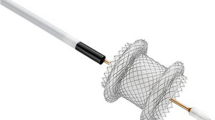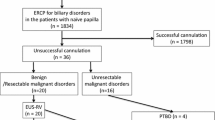Abstract
Background
Endoscopic ultrasonography (EUS)-guided interventions are often performed using a single guidewire (SGW), but there are a few reports on the use of double guidewire (DGW) technique to facilitate multiple drainage placement during EUS-guided drainage of pancreatic fluid collections. This DGW technique may have advantages other than multiple drainage placement during EUS-guided interventions such as scope stabilization, support for stone extraction and device insertion.
Methods
Consecutive patients who underwent EUS-guided interventions between Feb 2012 and Apr 2019 were retrospectively reviewed. The rate and reasons of DGW technique, and clinical outcomes were evaluated. DGW technique was performed, using an uneven double lumen cannula (UDLC), which facilitates insertion of 0.025-in. and 0.035-in. guidewires.
Results
A total of 249 EUS-guided interventions were analyzed, and DGW technique was utilized primarily in 65 cases (25.7%) and as a salvage after failed SGW technique in 18 cases (7.1%). The reasons for DGW technique were 60 multiple drainage placement, 10 scope stabilization, 7 device insertion, 5 safety guidewire, and 4 antegrade stone removal. Insertion of UDLC and DGW was successful in 100%. Technical success rate of preplanned interventions was 92.7% (96.9% in primary DGW and 77.8% in salvage DGW technique). Adverse events were observed in 19.5% after DGW but were not related to DGW technique.
Conclusions
DGW technique using UDLC during EUS-guided interventions was technically feasible and safe. In addition to multiple drainage insertion, it can potentially support complex EUS-guided interventions.




Similar content being viewed by others
References
Dhir V, Isayama H, Itoi T, et al. Endoscopic ultrasonography-guided biliary and pancreatic duct interventions. Dig Endosc. 2017;29:472–485.
Nakai Y, Isayama H, Yamamoto N, et al. Indications for endoscopic ultrasonography (EUS)-guided biliary intervention: does EUS always come after failed endoscopic retrograde cholangiopancreatography? Dig Endosc. 2017;29:218–225.
Minaga K, Kitano M. Recent advances in endoscopic ultrasound-guided biliary drainage. Dig Endosc. 2018;30:38–47.
Isayama H, Nakai Y, Itoi T, et al. Clinical practice guidelines for safe performance of endoscopic ultrasound/ultrasonography-guided biliary drainage: 2018. J Hepatobiliary Pancreat Sci. 2019;26:249–269.
Nakai Y, Isayama H, Yamamoto N, et al. Safety and effectiveness of a long, partially covered metal stent for endoscopic ultrasound-guided hepaticogastrostomy in patients with malignant biliary obstruction. Endoscopy. 2016;48:1125–1128.
Iwashita T, Nakai Y, Hara K, Isayama H, Itoi T, Park DH. Endoscopic ultrasound-guided antegrade treatment of bile duct stone in patients with surgically altered anatomy: a multicenter retrospective cohort study. J Hepatobiliary Pancreat Sci. 2016;23:227–233.
Laquiere A, Desilets E, Belle A, et al. Double guidewire endoscopic technique, a major evolution in endoscopic retrograde cholangiopancreatography: results of a retrospective study with historical controls comparing two therapeutic sequential strategies. Dig Endosc. 2017;29:182–189.
Tse F, Yuan Y, Moayyedi P, Leontiadis GI, Barkun AN. Double-guidewire technique in difficult biliary cannulation for the prevention of post-ERCP pancreatitis: a systematic review and meta-analysis. Endoscopy. 2017;49:15–26.
Seewald S, Thonke F, Ang TL, et al. One-step, simultaneous double-wire technique facilitates pancreatic pseudocyst and abscess drainage (with videos). Gastrointest Endosc. 2006;64:805–808.
Ang TL, Teo EK, Fock KM. EUS-guided drainage of infected pancreatic pseudocyst: use of a 10F Soehendra dilator to facilitate a double-wire technique for initial transgastric access (with videos). Gastrointest Endosc. 2008;68:192–194.
Itoi T, Itokawa F, Tsuchiya T, Kawai T, Moriyasu F. EUS-guided pancreatic pseudocyst drainage: simultaneous placement of stents and nasocystic catheter using double-guidewire technique. Dig Endosc. 2009;21:S53–S56.
Nakai Y, Kogure H, Koike K. Double-guidewire technique for endoscopic ultrasound-guided pancreatic duct drainage. Dig Endosc. 2019;31:65–66.
Ishiwatari H, Satoh T, Sato J, Kaneko J, Matsubayashi H, Ono H. Double-guidewire technique facilitates endoscopic ultrasound-guided biliary drainage for hilar biliary obstruction. Endoscopy. 2019;11:E321–E322.
Shiomi H, Masuda A, Kodama Y. Novel approach for successful endoscopic ultrasound-guided hepaticogastrostomy using a double-guidewire technique. Dig Endosc. 2019;31:e50–e51.
Inoue H, Yamada R, Takei Y. ‘Double guidewire in one catheter’ method for a difficult endoscopic retrograde cholangiopancreatography cannulation (with video). Dig Endosc. 2013;25:550–551.
Ogura T, Masuda D, Imoto A, Kamiyama R, Umegaki E, Higuchi K. Double-guidewire technique using a novel ERCP cannula for hepatic hilar obstruction. Endoscopy. 2014;46:E56–E57.
Takenaka M, Arisaka Y, Sakai A, et al. A novel biliary cannulation method for difficult cannulation cases using a unique, uneven, double-lumen cannula (Uneven method). Endoscopy. 2018;50:E229–E230.
Takenaka M, Yamao K, Kudo M. Novel method of biliary cannulation for patients with Roux-en-Y anastomosis using a unique, uneven, double-lumen cannula (Uneven method). Dig Endosc. 2018;30:808–809.
Cotton PB, Eisen GM, Aabakken L, et al. A lexicon for endoscopic adverse events: report of an ASGE workshop. Gastrointest Endosc. 2010;71:446–454.
Khashab MA, Giovannini M. How I do therapeutic EUS. Gastrointest Endosc. 2019;90:183–185.
Dollhopf M, Larghi A, Will U, et al. EUS-guided gallbladder drainage in patients with acute cholecystitis and high surgical risk using an electrocautery-enhanced lumen-apposing metal stent device. Gastrointest Endosc. 2017;86:636–643.
Tsuchiya T, Teoh AYB, Itoi T, et al. Long-term outcomes of EUS-guided choledochoduodenostomy using a lumen-apposing metal stent for malignant distal biliary obstruction: a prospective multicenter study. Gastrointest Endosc. 2018;87:1138–1146.
Nakai Y, Kogure H, Yamada A, Isayama H, Koike K. Endoscopic management of bile duct stones in patients with surgically altered anatomy. Dig Endosc. 2018;30:67–74.
Nakai Y, Isayama H, Koike K. Two-step endoscopic ultrasonography-guided antegrade treatment of a difficult bile duct stone in a surgically altered anatomy patient. Dig Endosc. 2018;30:125–127.
Mukai S, Itoi T, Sofuni A, et al. EUS-guided antegrade intervention for benign biliary diseases in patients with surgically altered anatomy (with videos). Gastrointest Endosc. 2019;89:399–407.
Kawakami H, Kubota Y, Makiyama H, Sato S, Ban T. Uneven double-lumen cannula for rescue guidewire technique in endoscopic ultrasonography-guided hepaticogastrostomy. Endoscopy. 2017;49:E264–E265.
Bhasin DK, Sharma BC, Gupta S, Singh K. Double guidewire placement in common bile duct: a technique for teaching biliary endoprosthesis placement. Gastrointest Endosc. 1998;48:453–454.
Vila JJ, Perez-Miranda M, Vazquez-Sequeiros E, et al. Initial experience with EUS-guided cholangiopancreatography for biliary and pancreatic duct drainage: a Spanish national survey. Gastrointest Endosc. 2012;76:1133–1141.
Poincloux L, Rouquette O, Buc E, et al. Endoscopic ultrasound-guided biliary drainage after failed ERCP: cumulative experience of 101 procedures at a single center. Endoscopy. 2015;47:794–801.
Author information
Authors and Affiliations
Corresponding author
Ethics declarations
Conflict of interest
The authors had no conflict of interests.
Additional information
Publisher's Note
Springer Nature remains neutral with regard to jurisdictional claims in published maps and institutional affiliations.
Rights and permissions
About this article
Cite this article
Nakai, Y., Oyama, H., Kanai, S. et al. Double Guidewire Technique Using an Uneven Double Lumen Catheter for Endoscopic Ultrasound-Guided Interventions. Dig Dis Sci 66, 1540–1547 (2021). https://doi.org/10.1007/s10620-020-06345-9
Received:
Accepted:
Published:
Issue Date:
DOI: https://doi.org/10.1007/s10620-020-06345-9




